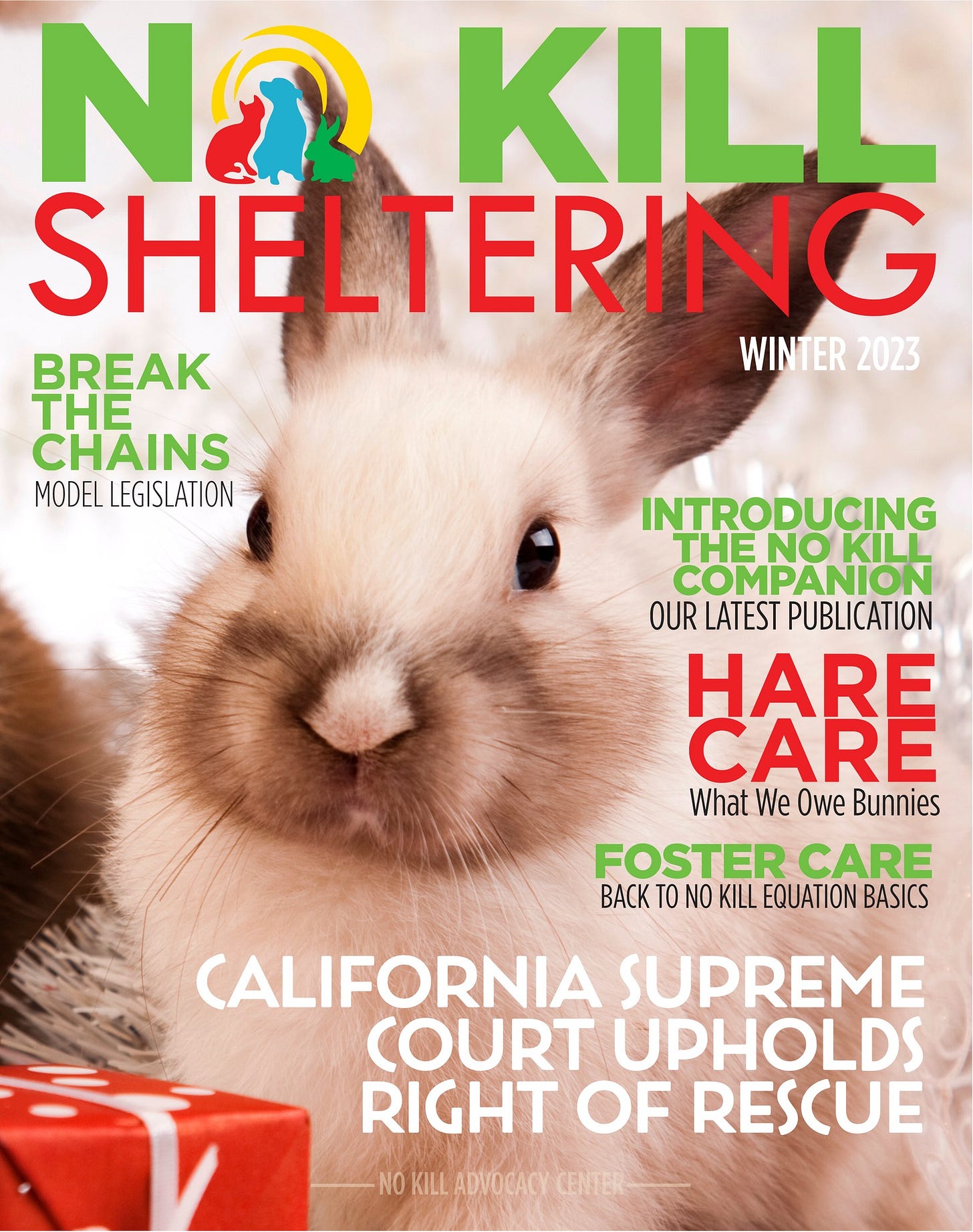California dog pounds seek power to kill more puppies
Using undemocratic trick to subvert unanimous Court of Appeal ruling protecting dogs and their rescuers
California’s regressive pound industry is trying to give itself the power to kill dogs even when rescue groups are ready, willing, and able to save them by introducing legislation to undo a unanimous Court of Appeal ruling that when rescuers offer to save them, “shelters” cannot kill dogs by claiming that "the animal has a behavioral problem or is not adoptable or treatable.” And they are doing it using one of the oldest tricks in the book: a “spot bill” that hides its true intentions.
The No Kill Advocacy Center is fighting back:
The Hon. Marc Berman, Chair, and Members
Committee on Business and Professions
California State Assembly
1315 10th St
Sacramento, CA 9581Re: No on AB 1988
Dear Chair Berman and Committee Members,
The No Kill Advocacy Center is the nation’s premier organization working to end the systematic killing of animals in shelters. We have helped municipal animal shelters achieve placement rates as high as 99%. We’ve written local, state, and national animal protection legislation. We have filed groundbreaking lawsuits to protect animals and empower their rescuers. And we consult with animal shelters all over the world.
Given that it currently serves no purpose, we write to express concerns that AB 1988 is a “holding” or “spot bill” designed to mask its true intentions — an effort to subvert the rescue provisions of the Hayden Law and the ability of non-profit rescue organizations to save dogs California shelters intend to kill. We expect that the bill will be amended to undo a recent Court of Appeal decision protecting dogs and their rescuers. If this is its intended purpose, the result will be more dead dogs and traumatized rescuers.
This includes dogs like Bowie and the women who tried to rescue him. Bowie was a 10-pound terrier surrendered to the Los Angeles County Department of Animal Care & Control (LACDACC). The family informed staff that they could not keep him because of their landlord’s no-pet policies.
Bowie was terrified, but no one on staff socialized him while he sat at the shelter, in a building off limits to staff and rescuers, for over three weeks in one of the country’s wealthiest and most cosmopolitan communities. No staff member tried to get him out of his shell. No one showed him the compassion and kindness that studies prove make a life-and-death difference for fearful dogs like Bowie.
Still, Bowie had an out. A rescue group came forward to give Bowie what staff at LACDACC would not: safe harbor and time — time to abandon fear, to forget a haunted past, and to learn that humans can be trusted after all. Most importantly, they offered to provide him with a loving home. It would be of no use. LACDACC chose to kill him without warning.
Instead of a new beginning, the little dog who should have had his whole life ahead of him, who posed no threat to anyone, was injected with an overdose of poison and turned to ash. He was barely 15 weeks old. And the women of Underdog Heroes, the rescuers who tried to save him, were left devastated, calling it a “gut punch.”
Despite this, LACDACC and California Animal Welfare Association, its lobbying organization, argued in court that they should be given the power to kill dogs like Bowie, but a unanimous Court of Appeal twice ruled that they should not for good reason. Despite fear-mongering about “dangerous and vicious” dogs, these dogs are already exempt from rescue, and there are no studies or other evidence to support their assertions of continued danger to public safety. In fact, there is ample evidence to the contrary.
A study that analyzed more than 10 years of California data found “no evidence that the problems predicted by some when the [Hayden] law was considered, such as… exposing the public to dangerous dogs, has ever materialized.”
Likewise, a study of a rescue ordinance in another state modeled on California’s found that while the placement of dogs climbed from 69% to 98%, the percentage of dog bites deemed moderate or severe declined by 13%, with the most significant decline in the number of bites classified as “severe,” which fell by 89%. The study concluded that the legislation was not only consistent with public safety, it also improved it, noting positive impacts on “public health, social capital, and community engagement,” which have “important implications for [a city’s] ability to promote and sustain the health and well-being of both its human and non-human animal residents.”
As a society, we owe a particular debt of gratitude to people who voluntarily offer a helping hand to those in need, including our nation’s homeless animals. Animal rescuers are compassionate people who open their hearts and homes to provide a safety net for animals others may have abandoned and whom our dysfunctional shelters betray even further by killing. Of course, it is the animals who pay the ultimate price when shelters kill dogs, but they are not the only ones who suffer. Animal rescuers and shelter volunteers are already donating their time, energy, resources, and love to make our world a better place. They shouldn’t have to sacrifice their emotional well-being, too.
Very truly yours,
Nathan Winograd
Supporters receive No Kill Sheltering, our magazine for saving lives.
Together, not only will we save lives, we will create a future where every animal will be respected and cherished and where every individual life will be protected and revered.



